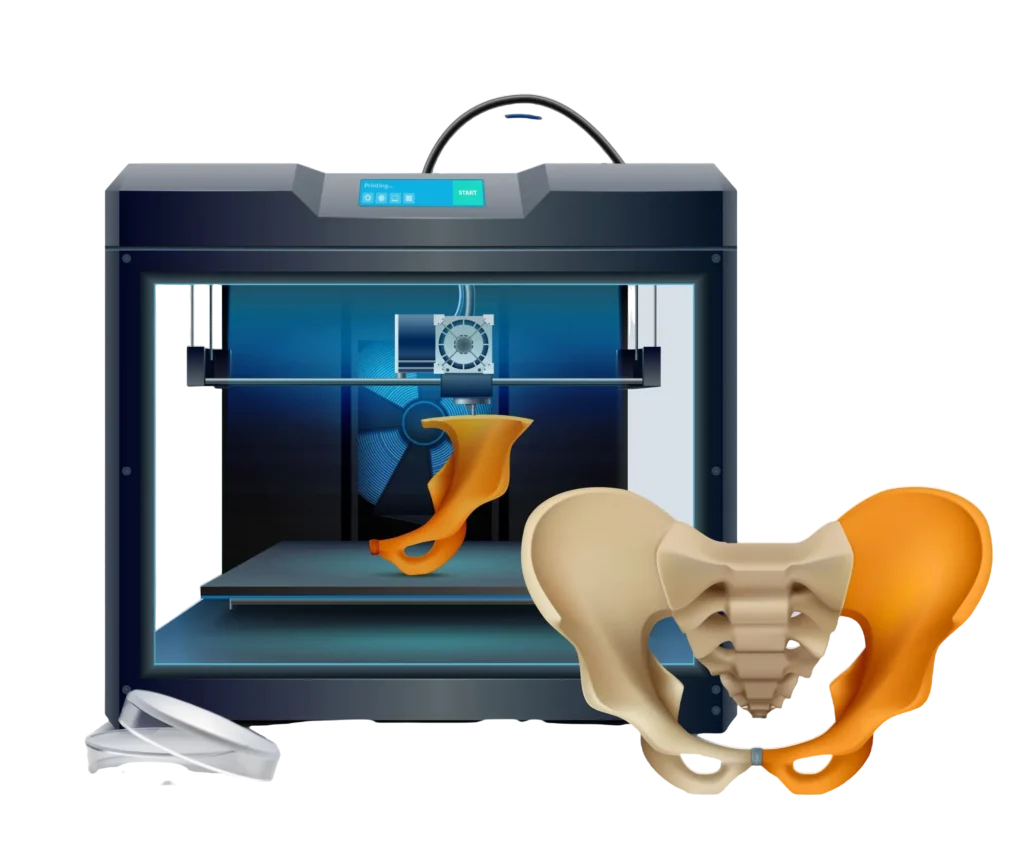The advent of 3D printing technology has been transformative across various industries, and healthcare is no exception. From customized prosthetics to groundbreaking advancements in bioprinting, 3D printing in healthcare is reshaping how treatments are delivered and improving patient outcomes. This technology’s ability to create personalized and complex designs has opened unprecedented opportunities, making healthcare more accessible, efficient, and innovative.
1. Revolutionizing Prosthetics with 3D Printing
Traditional prosthetics manufacturing is a costly and time-consuming process, often requiring multiple adjustments to ensure a proper fit. 3D printing has changed this narrative by enabling the creation of 3D printable prosthetics that are tailored to the individual needs of patients.
- Customization: Using 3D scanning and design software, prosthetics can now be made to fit a patient’s anatomy perfectly. This ensures better comfort and functionality.

- Affordability: 3D printers use less material and reduce labor costs, making prosthetics more affordable, especially in developing countries.
- Speed: A prosthetic limb that once took weeks to produce can now be printed in a matter of hours or days.
The rise of 3D printable prosthetics has empowered patients with disabilities, giving them access to affordable, high-quality solutions that significantly improve their quality of life.
2. Bioprinting: The Future of Regenerative Medicine

While 3D printable prosthetics address external physical needs, bioprinting takes 3D printing in healthcare a step further by focusing on internal medical applications. Bioprinting involves using bio-inks made from cells and biomaterials to create living tissues and organs.
- Tissue Engineering: Bioprinting has made it possible to create functional tissues for research, drug testing, and even transplantation.
- Organ Replacement: Though still in experimental stages, scientists are working toward printing organs like kidneys and livers, potentially solving the global organ donor shortage.
- Wound Healing: Researchers are developing 3D-printed skin grafts that can accelerate the healing process for burn victims and other patients with severe wounds.
Bioprinting holds the promise of revolutionizing medicine by offering customizable and scalable solutions to some of the most challenging healthcare problems.
3. Customized Medical Devices
Beyond prosthetics and bioprinting, 3D printing in healthcare is also transforming the production of medical devices such as surgical instruments, dental implants, and orthopedic supports.
- Dental Applications: Customized crowns, bridges, and orthodontic devices can now be printed with precision, reducing patient discomfort and treatment time.
- Surgical Guides: 3D-printed surgical models and guides enable surgeons to plan and execute complex procedures more effectively.
- Hearing Aids: Most modern hearing aids are manufactured using 3D printing, offering patients a perfect fit for optimal comfort and functionality.
These applications highlight how 3D printing is not only improving the quality of medical devices but also ensuring that they are more accessible to patients worldwide.
4. Training and Education in Healthcare
3D printing in healthcare is not limited to direct patient care; it is also playing a vital role in medical education and training.
- Anatomical Models: Medical students can now learn using 3D-printed models of organs, bones, and tissues that closely mimic real human anatomy.
- Surgical Simulations: Surgeons can practice procedures on 3D-printed replicas, enhancing their skills and reducing risks during actual surgeries.
- Public Health Education: Educators use 3D-printed models to teach communities about diseases and treatments, making healthcare more accessible.
5. The Challenges and the Way Forward
While 3D printing in healthcare offers immense potential, it does come with challenges. Regulatory approvals, ethical concerns, and the high initial cost of equipment are some hurdles that need to be addressed. However, as technology continues to advance and becomes more affordable, these challenges are expected to diminish, paving the way for even more groundbreaking applications.
Why Choose Us for Your 3D Printing Education?
If you’re inspired by the transformative power of 3D printing in healthcare and want to be a part of this innovative field, we can help you achieve your goals. Our institution is renowned as one of the best institutes for 3D printing courses in India, offering programs designed to equip you with the skills and knowledge needed to excel in this dynamic industry.
- 6-Month CAD Modeling and 3D Printing Course: Dive deep into the fundamentals of design and manufacturing, including hands-on training in creating 3D printable prosthetics and other healthcare applications.
- 3-Month Short-Term 3D Printing Course: Ideal for those seeking a quick yet comprehensive introduction to 3D printing.
Join us and become a pioneer in using 3D printing technology to revolutionize healthcare. Learn from industry experts and gain practical experience that sets you apart. Discover your potential with one of the top 3D printing courses in India todays!

